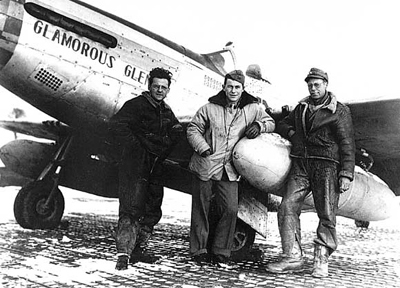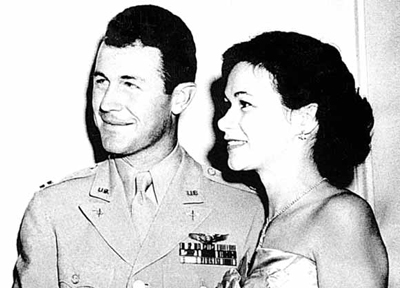Into the Lion’s Den: Combat Over Europe
By Shannon White
The 363rd Fighter Squadron completed its final two months of training at Casper, Wyoming. Before his unit headed east to depart for Europe, Chuck had arranged to spend a weekend in Reno with Glennis. Instead, he ended up in the base hospital at Casper. His P-39 caught fire during a training flight on 23 October and Chuck was forced to bail out. In doing so, he had fractured his back. He and Glennis would say their good-byes in Casper a few weeks later.
The entire 357th sailed for Europe aboard the Queen Elizabeth on 23 November, 1943. The Group was originally assigned to the 9th Air Force but once in England, they were reassigned and would become the first unit in the 8th Air Force to employ the new P-51 Mustang fighter.
A fast, sleek, and highly maneuverable design that went from the drawing board to the flight line in just 116 days, the Mustang included an indispensable element that would ultimately turn the tide of the war in Europe. Two 108-gallon external fuel tanks, one mounted beneath each wing, gave the nimble fighter a range that exceeded any of its predecessors. The pilots of the 357th would cut their teeth on the Mustang in the skies over Germany.
The air base at Leiston was just three miles from the North Sea coast near the village of Yoxford. When they set up housekeeping there in February 1944, the members of the 357th were surprised to hear an announcer on a German radio station welcome “The Yoxford Boys” to town.
The Group’s first combat mission was logged on 11 February, 1944. Flight Officer Chuck Yeager would score his first aerial victory a few weeks later on 4 March when he downed an Me-109 during one of the first daylight bombing raids over Berlin. But, as he soon learned, luck can change quickly in wartime.
The following day, 5 March 1944, Yeager was shot down while trying to make a head-on pass at a group of Fokke-Wolfe 190s during a raid on Bordeaux, France. Bailing out over Occupied territory was risky business. Even if he made it to the ground in one piece, Chuck knew his chances of avoiding German patrols were slim.
He waited until the last possible moment to open his parachute, then scanned the ground below as he descended. German troops seemed to be everywhere. After sweating out the ride down, he found himself in a forested area. Chuck rolled up his parachute and took cover in the heavy brush.
The next morning, as a French woodcutter made his way through the area, a pistol-wielding Chuck approached. His objective now was to avoid being captured at all costs and make his way into neutral Spain. He needed the help of the French underground if he was to succeed.
The startled woodcutter spoke no English, but understood that the young flier needed assistance. Soon, Chuck was under the watchful eyes of the Maquis – the French resistance movement. He spent the next few weeks traveling with the Maquis through the French countryside. He showed them how to set various timings for fuses on plastic explosives, something he had done years before with his Dad in the natural gas fields.
On 23 March, 1944, Chuck and three other downed American fliers were driven to the edge of the Pyrenees Mountains. The range forms a geographic barrier between France and Spain. Once on the other side, the men would be in neutral territory.
Chuck and a B-24 navigator would make the journey together. After four days of steady climbing through knee-deep snow and a relentless, freezing wind, the men were exhausted. They found a deserted cabin and decided to rest a while. The other airman hung his wet socks on a bush outside the cabin. He and Chuck were too tired to realize what a mistake that was.
Chuck was awakened by the sound of bullets hitting the cabin. A German patrol had passed by, seen the socks, and started shooting. The two men dove out a back window. Chuck threw his injured comrade on a snow-covered log slide and jumped on with him. The men ended up in a deep creek several thousand feet below the cabin. Once on the bank, Chuck tended to the other airman’s wound. Without Chuck he would have perished. Chuck then proceeded to drag his injured comrade back up the mountain.
Cold, wet, hungry, and with every muscle in his body aching, Chuck inched along. He did not stop for fear of falling asleep and letting go of his injured comrade. Finally, and practically without realizing it, Chuck reached the summit. Far below he could see a road. He pushed the unconscious airman down the slope and followed behind. Chuck left his injured comrade at the side of the road where border patrols could find him, and continued south. Now in Spain, he would soon have to turn himself in to the authorities.

Chuck Yeager With His Ground Crew

Yeager and Glennis
